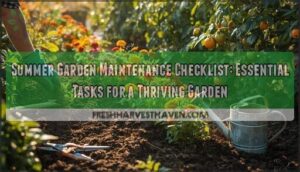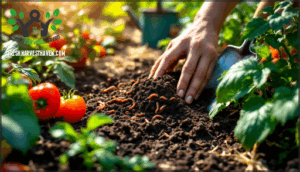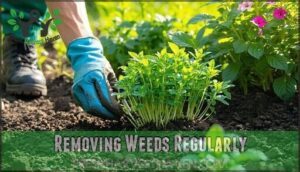This site is supported by our readers. We may earn a commission, at no cost to you, if you purchase through links.
 Your summer garden maintenance checklist starts with mulching to keep soil cool and moist, then moves to regular soil testing and aeration for healthy roots.
Your summer garden maintenance checklist starts with mulching to keep soil cool and moist, then moves to regular soil testing and aeration for healthy roots.
Pull weeds after rain, nip them in the bud before seeds spread, and lay down mulch to keep invaders at bay.
Deadhead blooms, prune with sharp tools, and choose heat-tolerant plants to keep your patch lively.
Keep pests in check with organic solutions and clean tools, and water deeply—your plants will thank you.
Efficient irrigation and timely harvesting round out the list.
Stick to these steps and your garden won’t just survive the summer, it’ll thrive—stay tuned for expert tips.
Table Of Contents
- Key Takeaways
- Soil Health Maintenance
- Weed Control Strategies
- Plant Care Techniques
- Pest and Disease Management
- Watering and Harvesting Tips
- Frequently Asked Questions (FAQs)
- How to plan a summer garden?
- How many times a day should you water your garden in the summer?
- Is July too late to start a garden?
- How do you make a beautiful low maintenance garden?
- How to ensure proper drainage in garden beds?
- What are best practices for companion planting success?
- How can one attract more pollinators to gardens?
- What tools are essential for summer garden upkeep?
- How to protect plants from extreme heatwaves?
- How do I protect my garden from heatwaves?
- Conclusion
Key Takeaways
- Start with mulching and soil health – You’ll protect your plants by applying a 2-inch thick mulch to retain moisture, prevent weeds, and keep roots cool during summer heat waves.
- Stay ahead of weeds with regular removal – You’ll save time and effort by pulling weeds after rain when the soil’s moist and preventing them from setting seed before they spread.
- Use proper pruning and deadheading techniques – You’ll encourage continuous blooms and healthy growth by deadheading spent flowers and using sharp, clean tools for precise cuts.
- Implement efficient watering and pest control – You’ll maintain a thriving garden by watering deeply in the early morning or evening, monitoring for pests weekly, and using organic solutions like neem oil when needed.
Soil Health Maintenance
You need to pay close attention to soil health during summer, as maintaining proper structure and fertility is essential for supporting healthy plant growth.
By focusing on mulching for soil protection, adjusting soil conditions, and adding organic matter, you can guarantee your garden thrives even in the hottest months.
Mulching for Soil Protection
When summer’s heat is relentless, soil mulching becomes your garden’s best shield. Mulching helps maintain soil temperature and moisture retention, supporting plant growth and weed control.
Mulching is your garden’s secret weapon against summer heat, keeping roots cool and moisture locked in
You’ll find these benefits with different mulch types and organic matter:
- Reduces evaporation by nearly 70%
- Keeps root zones cooler
- Minimizes erosion and compaction
- Boosts nutrient cycling for healthy plants
- Suppresses weeds, saving time on garden maintenance
Effective garden mulching often involves choosing the right Garden Mulch Products to achieve ideal results, and it supports healthy plants through various means.
Adjusting Soil Conditions
Once you’ve mulched, it’s time to focus on adjusting soil conditions.
Start with soil testing to check pH balancing and nutrient cycling, which helps you target garden fertilizers for better plant growth and weed control.
If your soil feels compacted, try soil aeration to boost root health.
Compost tea can also improve soil structure, making lawn care easier and helping your plants thrive all summer long. Understanding soil health basics is essential for maintaining a thriving garden ecosystem.
Adding Organic Matter
Throughout summer gardening, enriching your soil with organic matter acts as the foundation for robust plant growth and long-term soil health.
Regular additions of compost, aged manure, and other natural amendments create a thriving ecosystem that supports beneficial microorganisms and improves nutrient retention.
- Test soil pH levels before applying organic fertilizers to guarantee ideal nutrient absorption
- Layer compost around established plants, working it into the top four inches of soil
- Choose appropriate mulch types like shredded leaves or grass clippings for gradual decomposition
- Apply natural amendments such as bone meal or kelp meal during active growing periods
- Schedule yard cleanup to collect organic materials for future compost production, maximizing soil enrichment benefits
Weed Control Strategies
Weeds compete directly with your garden plants for water, nutrients, and sunlight, making regular removal essential for maintaining a healthy summer garden.
You’ll need to stay ahead of these unwanted invaders by implementing consistent control strategies that prevent them from establishing deep roots and producing seeds, which is crucial for preventing the spread of weeds and maintaining the health of your garden plants.
Removing Weeds Regularly
Weeds compete aggressively with your plants for nutrients and water during summer gardening season.
Pull weeds by hand when soil is moist, making manual removal easier and ensuring you extract complete root systems. Choose appropriate gardening tools like hoes for larger areas or hand weeders for precise garden pests control.
Regular weed identification helps you target problem species before they establish deep roots, requiring less frequent yard cleanup and garden watering adjustments.
Preventing Seed Production
Timing is everything—catching weeds before they set seed saves you from a future invasion.
Use sharp gardening tools for Seedling Removal and master plant pruning and Pruning Techniques to nip bolting in the bud.
Deadheading Flowers and careful Herb Management keep unwanted spread in check, while flower care and garden watering routines help minimize stress and discourage garden pests.
Employing double-break tactics can further reduce the weed seedbank in crop sequences.
Using Mulch to Suppress Weeds
After stopping weeds before they set seed, you’ll want to block their next move.
Choosing the right mulch types—like shredded wood, pine straw, or grass clippings—lets you smother weed seedlings.
Apply mulch to a depth of two inches, which disrupts the weed lifecycle.
Organic mulch thickness of 3-4 inches can reduce weed growth by up to 98%.
Organic options and mulch alternatives also help conserve moisture, support plant pruning, and fit summer landscaping routines.
Regular Garden Maintenance
If you want your summer landscaping to look its best, regular garden maintenance is key.
Focus on tool maintenance, path maintenance, and keeping support structures sturdy.
Keep up with shrub maintenance and tree trimming for a tidy yard.
Seasonal adjustments in irrigation systems help conserve water, while thoughtful garden planning lets you adapt to changing conditions and keep weeds from gaining ground.
Plant Care Techniques
You’ll need to focus on careful deadheading, precise pruning, and regular pinching to keep your plants healthy and productive throughout the summer.
Selecting heat-tolerant varieties guarantees your garden withstands seasonal stress while maintaining steady growth and vibrant blooms, which is crucial for a garden to be productive.
Deadheading for Continuous Blooming
After tackling weeds, shift your focus to Spent Bloom Removal for continuous color.
Deadheading Techniques, like snipping faded flowers with sharp pruners, encourage new growth and Bloom Time Extension.
Tool Selection matters—choose clean, precise shears for shrub maintenance.
Regular deadheading during the summer season keeps yard landscaping vibrant, supports garden renovation goals, and helps plants adapt to seasonal weather patterns, which is crucial for continuous color.
Pruning for Shape and Health
When you embrace proper pruning techniques during the summer season, you’re not just encouraging growth; you’re shaping your garden’s structural integrity.
Select sharp, clean tools for precise cuts, and consider wound sealing for larger branches to prevent disease.
Pruning helps keep outdoor decor tidy, supports patio maintenance, and can even kickstart a garden renovation or yard landscaping project.
Pinching Back Plants
Pinching back plants is a simple way to encourage bushiness and promote blooms, keeping your outdoor decor vibrant despite seasonal changes and summer rainfall.
Try these steps for precise agricultural management:
- Use correct pinching techniques.
- Remove suckers regularly.
- Shape plants for patio maintenance.
- Pinch growing tips to stimulate growth.
- Maintain consistent care for best results.
By following these steps, you can ensure your outdoor space remains vibrant and well-maintained, making the most of your patio decor.
Planting Heat-Tolerant Varieties
Although summer rainfall can be unpredictable and heat waves are common, choosing the right Variety Selection for your Hardiness Zones makes all the difference.
Focus on plants that thrive in high Sun Exposure and tolerate Soil Temperature swings.
Consider Watering Needs and drought conditions, and start greenhouse germination early for heat-tolerant vegetables.
This approach helps you master temperature variation and maintain a resilient garden.
Pest and Disease Management
You’ll need to stay alert for pests and diseases throughout the summer, as warm weather and frequent watering create ideal conditions for outbreaks.
Regular inspection, careful tool cleaning, and timely use of organic controls are essential steps to protect your plants and maintain a healthy garden environment.
Monitoring for Pests and Diseases
Keep an eye out for unusual leaf spots, wilting stems, or insect activity during the summer months, as Early Detection is key to Pest Identification and Disease Prevention.
Spot trouble early—catch leaf spots or wilting fast to keep your summer garden healthy and pest-free
Integrated Management means inspecting plants weekly, especially after summer activities or drought conditions, and checking greenhouse germination areas.
Natural Remedies work best when you catch problems early, helping maintain strong agricultural management all season.
Using Organic Pest Control
Relying on organic pest control helps you protect food production while reducing environmental impact and supporting ecological conservation.
Try these practical methods:
- Apply neem oil for soft-bodied pests.
- Use diatomaceous earth for crawling insects.
- Practice companion planting for beneficial insects.
- Select organic pesticides with care.
- Monitor agricultural management to adapt to climate change.
By following these steps, you can effectively manage pests in an environmentally friendly manner.
Introducing Natural Predators
Every gardener benefits from introducing natural predators, like Beneficial Insects and birds, to keep pests in check.
Install Bird Houses to attract allies, release Ladybugs for Aphids, and use nematodes for Nematode Control.
Creating Predator Habitats supports Agricultural Management and Ecological Conservation, reducing Environmental Impact.
Seasonal Variations and Climate Change may shift predator populations, so monitor your garden’s balance.
Planting umbelliferous flowers can help with attracting beneficial insects to support Ecological Conservation.
Cleaning Garden Tools
Just as natural predators help keep pests in check, cleaning garden tools is your next defense.
Tool Disinfection stops diseases from spreading, while Blade Sharpening keeps cuts clean and plants healthy.
Rust Prevention and Handle Maintenance guarantee longevity, especially with unpredictable weather patterns and climate change.
Use smart Storage Solutions, remembering that summer solstice in the northern hemisphere signals peak seasonal patterns for garden activity.
Watering and Harvesting Tips
You need to focus on both consistent watering and timely harvesting to keep your garden productive throughout the summer.
By using efficient irrigation methods and adjusting your schedule as needed, you’ll help your plants thrive and guarantee a steady supply of fresh produce.
Providing Adequate Watering
After tackling pests and diseases, turn your attention to watering frequency.
Deep watering encourages strong roots, while efficient methods like drip irrigation save time and promote water conservation.
Tailor your approach to plant-specific needs, factoring in climate conditions, geographical variations, and seasonal patterns.
To help retain moisture, consider applying organic mulch types around your plants.
Stay alert to weather patterns, and consider educational programs for best practices, ensuring your garden thrives all summer.
Harvesting Vegetables Frequently
Once you’ve got watering down, it’s time to focus on harvesting vegetables frequently.
Picking at peak ripeness enhances flavor, and also encourages extended production, helping you outsmart pests and prevent disease.
Across the northern and southern hemisphere, seasonal changes and climate conditions shape harvest times, so stay alert to your geographical region’s cues for best results.
Using Efficient Irrigation Systems
Drip Irrigation and Soaker Hoses are your best bet for water conservation, as they deliver moisture right to plant roots and cut evaporation.
For efficient watering solutions, consider exploring a complete drip system.
Pair these with Smart Controllers that adjust watering based on recurring weather patterns and Climate Change Research.
Rainwater Harvesting also helps, especially in the northern and southern hemisphere’s dry spells, keeping your garden thriving across all geographical regions.
Adjusting Watering Schedules
A well-timed watering schedule keeps your garden thriving and helps with water conservation, especially with recurring weather patterns and climate change research highlighting seasonal changes.
Use these tips:
- Adjust for northern or southern hemisphere seasons.
- Water early or late to aid evaporation minimization.
- Prioritize deep watering.
- Monitor plant needs weekly.
- Update schedules as weather changes to ensure your garden remains healthy and thriving.
Frequently Asked Questions (FAQs)
How to plan a summer garden?
If Julius Caesar had a garden, you’d start by choosing sun-loving, drought-tolerant plants.
Prepping soil with compost, planning irrigation, mulching for moisture, and scheduling regular harvests are crucial steps.
Don’t forget to monitor for pests and prune for healthy growth.
How many times a day should you water your garden in the summer?
You’ll want to water your garden once a day, preferably early morning or late evening, to minimize evaporation.
Overwatering can drown roots, so stick to deep, infrequent watering—think of it as giving plants a rejuvenating drink.
Is July too late to start a garden?
Imagine planting seeds after a rainstorm—nature’s timing isn’t always perfect.
July isn’t too late; you can still grow fast-maturing vegetables, herbs, and flowers.
Focus on heat-loving crops and keep soil moist for best results.
How do you make a beautiful low maintenance garden?
Choose native plants, spread mulch to keep weeds down, and use drip irrigation for easy watering.
Group plants by water needs, prune lightly, and raise your mower height; you’ll enjoy a lush garden without constant fuss.
How to ensure proper drainage in garden beds?
Roughly 30% of plant failures stem from poor drainage, making this garden fundamental essential.
Create sloped beds angling away from structures, incorporate coarse materials like gravel beneath soil, and install French drains for persistent water issues.
What are best practices for companion planting success?
Plant complementary crops together by grouping heavy feeders with light feeders, pairing pest-repelling herbs near vulnerable vegetables, and ensuring compatible root depths and growth habits for ideal space utilization.
How can one attract more pollinators to gardens?
You’ll boost pollinator populations by planting native flowering plants that bloom throughout seasons, providing continuous nectar sources.
Create shallow water features, avoid pesticides, and include herbs like lavender and bee balm to make your garden irresistible to bees, butterflies, and hummingbirds, which will also attract hummingbirds.
What tools are essential for summer garden upkeep?
Are your garden tools ready to weather summer’s scorching demands?
You’ll need sharp pruning shears, a reliable hose or soaker system, a sturdy rake, and quality mulching materials to keep your plants thriving through heat and drought stress.
How to protect plants from extreme heatwaves?
During extreme heat, you’ll need to create shade using cloth or umbrellas, water deeply early morning, apply thick mulch around plants, and temporarily relocate containers to cooler spots for protection.
How do I protect my garden from heatwaves?
Apply thick mulch around plants to retain soil moisture and keep roots cool.
Water deeply at soil level during early morning or evening hours.
Use shade cloth or temporary covers during peak heat to shield vulnerable plants from scorching sun, and remember to apply thick mulch to retain soil moisture.
Conclusion
Following this summer garden maintenance checklist consistently, watering adequately, and harvesting regularly will transform your outdoor space into a productive sanctuary.
You’ve learned to protect soil with mulch, control weeds before they spread, and maintain plants through proper pruning techniques.
Your garden responds to attention with abundant growth when you monitor for pests, use organic solutions, and adjust irrigation schedules accordingly.
These essential tasks guarantee your summer garden maintenance checklist delivers lasting results throughout the growing season, ensuring a successful and abundant growth.










